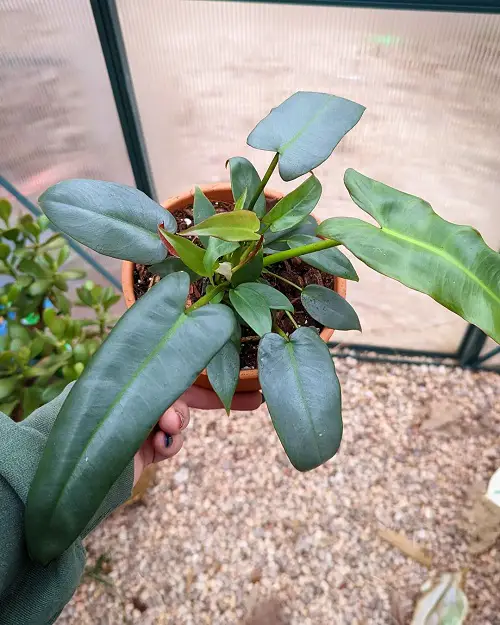Philodendron atabapoense Care is not a difficult task if you have the right guidance. Read on to learn the expert tips!

Philodendron atabapoense is a stunning tropical plant with elongated, glossy leaves and is native to South America. Proper care and maintenance can help it thrive and bring a touch of tropical vibes into your home or office.
Read about Philodendron Linnaei Propagation and Care Tips
Philodendron atabapoense Plant Information

Philodendron atabapoense is a tropical plant species native to South America, specifically the region surrounding the Atabapo River in Colombia, Venezuela, and Brazil. It belongs to the family Araceae.
It features large, heart-like leaves that can grow up to 1-2 feet in length. The foliage has a glossy texture and gets a deep green color, with prominent veins that give it a striking appearance. The thick stems have a vine-like growth that allows them to climb and trail as they grow.
Philodendron atabapoense is also popular for its air-purifying qualities. The plant is able to filter toxins such as formaldehyde and benzene from the air, making it a popular choice for indoor spaces such as homes and offices.
Read about Philodendron Spiritus Care
Propagating Philodendron atabapoense

Use a clean, sharp knife or scissors and take 4-6 inches long stem cutting. Make sure the cutting has 3-4 leaves and nodes. Remove the lower leaves, leaving 1-2 leaves at the top. Dip the cut end of the stem cutting in rooting hormone powder to encourage root growth. Plant the stem cutting in a small pot filled with a well-draining potting mix. Water the soil thoroughly. To promote successful rooting, provide adequate humidity by placing a clear plastic bag or dome over the cutting.
Place the pot in a location with bright, indirect light. Avoid direct sunlight, which can damage the cutting. Water the cutting as needed to keep the soil moist but not waterlogged. The cuttings will form roots in 4-5 weeks.
Requirements for Growing Philodendron atabapoense

Light
It prefers moderate light, although it can also adapt to low-light conditions. Ideally, it should be placed in a location with bright but diffused or dappled light.
Avoid direct sunlight, as it can cause the amazing colors of the leaves to diminish.
Soil
Use loose, well-drained organic soil. Improve drainage and aeration by adding orchid bark or a small amount of sand to the planter. To balance this out and prevent the soil from drying out too quickly, peat moss or sphagnum moss can be mixed in with the potting mix.
The ideal pH level for the soil should be between 6.1 and 7.3, which is slightly acidic but not neutral.
Water
Watering once or twice a week during spring and summer is recommended. Decrease the watering frequency during fall and winter. It is crucial to wait until the top 2 inches of potting mix are completely dry before watering again.
Temperature & Humidity
Philodendron atabapoense prefers temperatures between 65-80°F (18 and 27°C). It is important to avoid exposing the plant to temperatures below 50°F (10°C), as this can damage or kill it.
Additionally, avoid exposing the plant to sudden temperature fluctuations, as this can cause stress and affect its growth.
It needs high humidity levels, ideally between 50-60%. If the air is too dry, the leaves may turn brown or develop brown tips.
You can increase humidity levels around the plant by misting the leaves regularly, placing a tray of water and pebbles near the plant, or using a humidifier.
Philodendron atabapoense Care

Fertilizer
Apply a balanced liquid fertilizer 2-3 times a year in spring or summer. Avoid feeding the plant in winter.
Pruning
Only light trimming is necessary for this plant. Remove any dead or damaged leaves or stems to allow the plant to concentrate its energy on new growth. Light pruning can also encourage fuller growth.
Avoid heavy pruning as it can shock the plant. Only prune when necessary and avoid cutting away too much at once.
Re-potting
In early spring or summer, consider repotting your plant if the soil becomes compact or if roots are exposed. Repotting every 2-3 years is advisable to maintain soil nutrients. Additionally, when repotting, it will be better to support your climbing philodendron.
Consider adding a moss pole or trellis to promote robust leaf growth and encourage upward growth.
Pests and Diseases
Philodendron atabapoense is a sturdy plant, but it is highly susceptible to overwatering, which can result in root rot. It is essential to water the plant only when the top layer of the potting mix has dried out.
Another common issue with these plants is spider mites. These pests extract sap from the leaves and stems of the plant, depriving it of nutrients. Spray the plant with an organic insecticide solution or neem oil.


